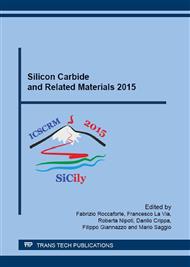p.353
p.357
p.361
p.367
p.371
p.376
p.380
p.384
p.389
Observation of Pair Structures of Threading Dislocation and Surface Defect in 4H-SiC Wafer by Mirror Projection Electron Microscopy
Abstract:
Two types of shallow surface defects associated with treading dislocation were found out by using mirror projection electron microscope. One was single groove with a dimension of about 4 nm in depth, 2 μm in width and 15 μm in length, named “as nanogroove”. The other was a shallow groove at 1.3nm in depth being between pair of hillocks at 2-3 nm in height and 1.5 μm in distance, named as “nanohillock pair”. Dislocations combined with the defects were found out by micro-KOH etching method with low-energy scanning electron microscopy. The dislocations were identified by g-b analysis using scanning transmission electron microscopy as threading edge dislocations converted from basal plane dislocation at bulk-epi layer interface or within epi layer.
Info:
Periodical:
Pages:
371-375
Citation:
Online since:
May 2016
Authors:
Price:
Сopyright:
© 2016 Trans Tech Publications Ltd. All Rights Reserved
Share:
Citation:


